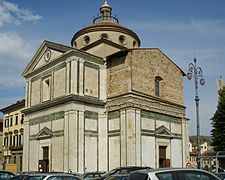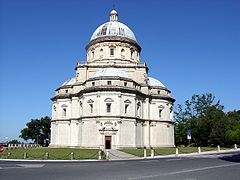Greek cross


The Greek cross or crux immissa quadrata is a cross formed by four arms of equal size that intersect at right angles.
In architecture, the intersection of nave and transept gives churches a cross plan. A Greek cross plan is used for churches in which the nave and transept have the same length and intersect at half their length. When the nave and transept are of different lengths, it is called a Latin cross plan.
It is typical of Byzantine architecture: the prototype is the already destroyed Church of the Holy Apostles in Constantinople, later recreated in Italy during the early Middle Ages, but almost completely replaced by the Latin cross with the arrival of the Romanesque. A famous example of a Byzantine-inspired Greek cross church is St. Mark's Basilica in Venice. In the Orthodox churches of Eastern Europe the Greek cross has been used from the Middle Ages to the present day, with the term cross-in-square, cross-dome or inscribed cross church (cross-in-square and crossed-dome in English, église à croix inscrite in French, Kreuzkuppelkirche in German, Βυζαντινός ρυθμός in Greek and Крестово-купольный храм in Russian). A particular form is the tetraconcha (four shells).
The Greek cross plan was taken up in central Italy during the Renaissance, when several buildings with a central plan were built: Filippo Brunelleschi experimented with it in the Old Sacristy of San Lorenzo and used it in the Pazzi Chapel. The Sangallo brothers were inspired by the result: first Giuliano built the Basilica of Santa Maria delle Carceri in Prato, then Antonio designed the church of San Biagio in Montepulciano; Also from the same period are the Temple of Santa Maria della Consolación in Todi (although the attribution is uncertain) and the original project by Donato Bramante and Michelangelo for St. Peter's Basilica in Vatican City. Bramante reintroduced this typology also in northern Italy. Another example of a church with a Greek cross is the church of Sant'Egidio, better known as the church of Sangallo, in Cellere (province of Viterbo).
- Renaissance central churches
Church of San Biagio in Montepulciano
Basilica of Santa Maria delle Carceri in Prato
Temple of Saint Mary of the Consolation of Todi
With the Church of the Gesù in Rome and with the modification of the project of Saint Peter, the experiments with a Greek cross plan were ended, to better apply the harmony of the Renaissance through the use of plans with a Latin cross. However, during the Baroque, Pietro da Cortona created the church of Saints Luca and Martina in Rome using a slightly elongated Greek cross; In addition, the church of San Carlo ai Catinari (also in Rome) and the Sorbonne chapel (1635-1642), in Paris, the work of Jacques Lemercier, can also be considered Greek cross plans.
Contenido relacionado
Santes Creus Monastery
Church of Santa Maria de Melque
Royal Monastery of San Juan de la Peña
Minaret
Basilica


